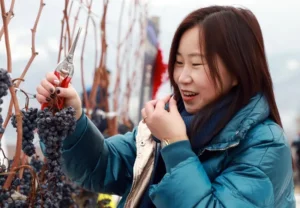In Tonghua’s frozen vineyards, native grapes and Canadian expertise yield an ice wine vintage that is winning global acclaim.
Tonghua, North East China — The Yalu River cuts a restless line between China and North Korea, flanked by the ridges of the Changbai Mountains. In the valleys below, summer sunlight ripens grapes that will hang into winter, where they freeze into purple beads of ice. From this unlikely borderland comes a wine now winning international respect: Chinese ice wine.
Once known for “red national wine” poured at state banquets, Tonghua and the nearby city of Ji’an have reinvented themselves through a mix of tradition, science, and collaboration, including a pivotal role played by a Canadian winemaker.
A Diplomatic Legacy
Tonghua’s connection to wine stretches back nearly a century. By the 1930s, the region was already producing industrial quantities of wine from a hardy local grape known as amulu. After the founding of the People’s Republic in 1949, Tonghua Wine was elevated to the status of “national wine.” It was served at the National Day banquet and poured for visiting leaders from Richard Nixon to Margaret Thatcher.
Stored in vast underground cellars lined with oak casks, Tonghua’s wines became a kind of liquid ambassador. For decades, the state leaned on this “diplomatic calling card” as proof of China’s sophistication and hospitality.
But as the wine market modernized in the 1990s, prestige alone was not enough. To remain relevant, Tonghua needed a new story.
Betting on China Ice Wine
That story emerged from the frost itself. Ice wine, a luxury style produced from naturally frozen grapes, was well established in Germany and Canada. Could the harsh winters of Jilin Province produce something similar?
In 1997, a team from Tonghua travelled to Canada to study ice wine firsthand. Six years later, in 2003, the Canadian winemaker Dominic Rivard arrived in Tonghua to help answer the question.
Dominic’s assignment was to test whether the Canadian Vidal grape, the workhorse of Canadian ice wine, could adapt to the unfamiliar conditions of northeast China. “We started small, with trial plots across different vineyards,” Rivard recalled. “We tracked sugar levels, acidity, and flavours. Slowly, the vines proved they could thrive here.”
From a few hectares, the trials expanded into commercial plantings. “It was a true collaboration,” he said, “Canadian expertise meeting Chinese persistence.”
Dominic later returned to Canada carrying bottles of Tonghua ice wine and late-ripening mountain grapes. “Tonghua’s use of oak barrels, its handling of frozen fruit, surprised us,” he said. “The exchange lifted both sides. The lesson was clear: respect the local climate and adapt everything to it, grapes, vineyards, winemaking.”
A Grape of Their Own
At the same time, Chinese scientists were developing varieties suited to their environment. Chief among them was Beibinghong, the world’s first mountain grape bred specifically for ice wine. Unlike its wild ancestors, it could withstand the freeze while yielding wines with the deep ruby hue and complex aromas of honey, dates, and raisins.
For local vintners, Beibinghong was proof that China could make a genetic contribution to the global wine conversation, not merely borrow from Europe or North America.
Winning on the World Stage
The gamble is paying off. This summer, Ji’an’s Yalu Valley Winery learned that a dry red made from Beibinghong had won a gold medal at the Brussels International Wine Awards. “This is truly a Chinese grape, a Chinese wine,” said general manager Kong Qingsen. “It gives our small city an international calling card.”
In recent years, wines from Tonghua and Ji’an have won medals across Japan, Korea, Russia, and Austria. The walls of local wineries are lined with certificates. “Going abroad is the only way to know how good your wine is,” said Sun Yanfeng, who heads Ji’an’s mountain grape wine research center. “The first time we entered a competition, we were nervous. But we won, and that gave us confidence.”
Festivals and Visitors
Wine has also become a draw for tourism. Each winter, Ji’an hosts an Ice Wine Festival where visitors marvel at clusters of frozen grapes hanging like glass beads in the snow. Korean drum performances mark the harvest, while tourists from Russia, France, and Germany taste the wines.
German taster Georg Philipp, who has judged international competitions, was impressed on his first visit to Jilin. “The balance of acidity and sweetness is excellent,” he said after sampling Beibinghong ice wine. “You can taste the region itself.”
A Borderland’s Voice
Tonghua’s vineyards carry a dual legacy. On one side, they preserve the heritage of wines once poured for foreign leaders at moments of statecraft. On the other hand, they embrace experimentation, hybridizing grapes, working with Canadian experts like Dominic Rivard, and proving themselves in competitions abroad.
The volumes are small, and the world’s most famous terroirs still dominate the conversation. But in this valley, where rivers mark national boundaries and grapes endure frost, China has found a flavour no one else can quite copy.
As Dominic put it: “What Tonghua built is not just Chinese or Canadian, it’s something new. And the world is starting to notice.”

